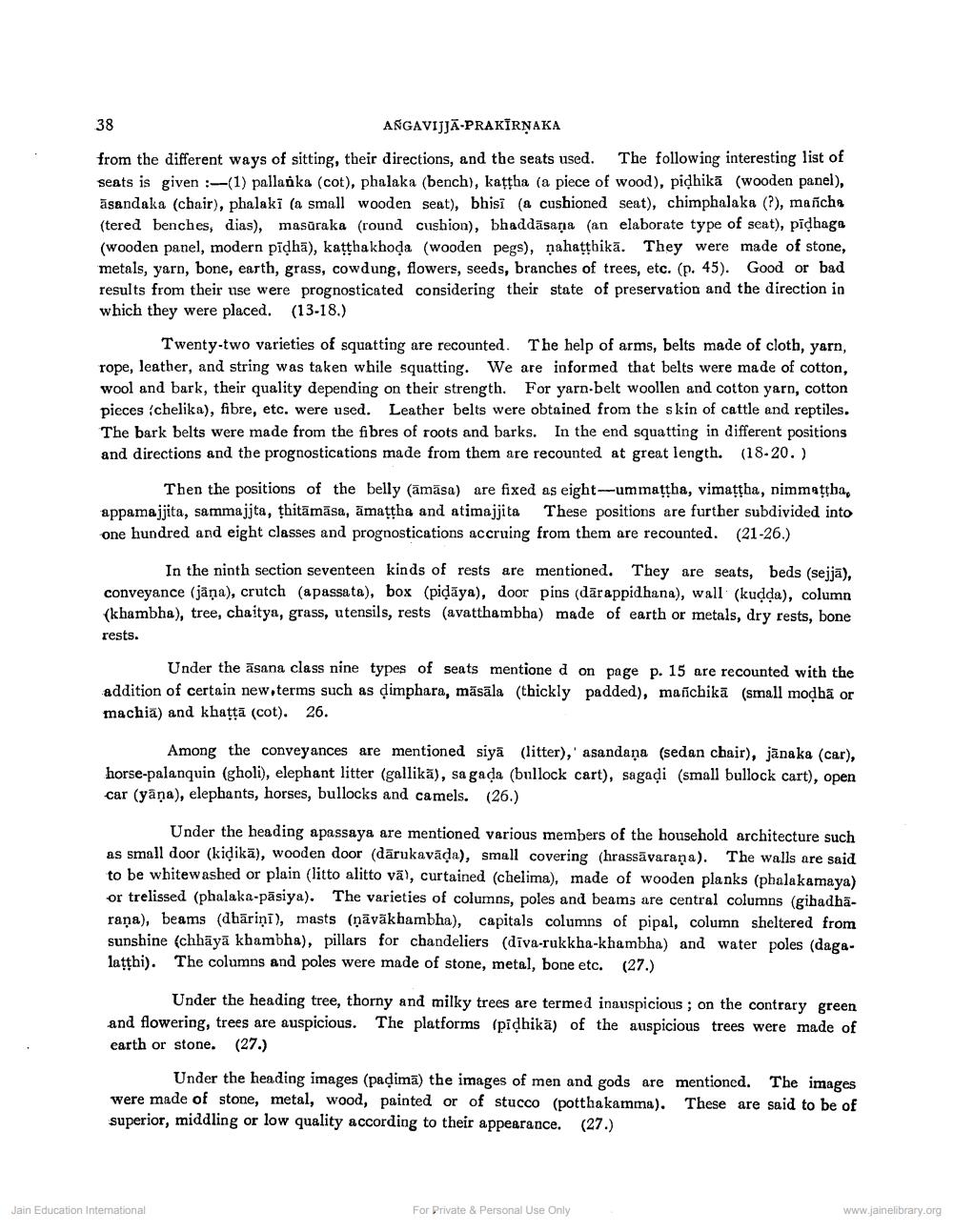________________
38
AKGAVIJJA-PRAKIRŅAKA from the different ways of sitting, their directions, and the seats used. The following interesting list of seats is given :-(1) pallaoka (cot), phalaka (bench), kattha (a piece of wood), pidhikā (wooden panel), āsandaka (chair), phalakī (a small wooden seat), bhisi (a cushioned seat), chimphalaka (?), manche (tered benches, dias), masaraka (round cushion), bhaddāsaņa (an elaborate type of seat), pidhaga (wooden panel, modern pidhā), katthakhoda (wooden pegs), nahathikā. They were made of stone, metals, yarn, bone, earth, grass, cowdung, flowers, seeds, branches of trees, etc. (p. 45). Good or bad results from their use were prognosticated considering their state of preservation and the direction in which they were placed. (13-18.)
Twenty-two varieties of squatting are recounted. The help of arms, belts made of cloth, yarn, rope, leather, and string was taken while squatting. We are informed that belts were made of cotton, wool and bark, their quality depending on their strength. For yarn-belt woollen and cotton yarn, cotton picces chelika), fibre, etc. were used. Leather belts were obtained from the skin of cattle and reptiles. The bark belts were made from the fibres of roots and barks. In the end squatting in different positions and directions and the prognostications made from them are recounted at great length. (18.20.)
Then the positions of the belly (āmāsa) are fixed as eight-ummattha, vimațsha, nimmatha, appamajjita, sammajjta, țhitāmāsa, āmatha and atimajjita These positions are further subdivided into one hundred and eight classes and prognostications accruing from them are recounted. (21-26.)
In the ninth section seventeen kinds of rests are mentioned. They are seats, beds (sejja), conveyance (jāņa), crutch (a passata), box (piļāya), door pins (dārappidhana), wall (kuqda), column (khambha), tree, chaitya, grass, utensils, rests (avatthambha) made of earth or metals, dry rests, bone rests.
Under the asana class nine types of seats mentioned on page p. 15 are recounted with the addition of certain new terms such as dimphara, māsāla (thickly padded), manchikā (small modbā or machia) and khatā (cot). 26.
Among the conveyances are mentioned siyā (litter),' asandana (sedan chair), jānaka (car), horse-palanquin (gholi), elephant litter (gallika), sa gada (bullock cart), sagadi (small bullock cart), open car (yāņa), elephants, horses, bullocks and camels. (26.)
Under the heading apassaya are mentioned various members of the household architecture such as small door (kidikā), wooden door (dārukavāda), small covering (hrassavarana). The walls are said to be whitewashed or plain (litto alitto vā), curtained (chelima), made of wooden planks (phalakamaya) or trelissed (phalaka-pāsiya). The varieties of columns, poles and beams are central columns (gihadharana), beams (dhāriņi), masts nāvākhambha), capitals columns of pipal, column sheltered from sunshine (chhāyā khambha), pillars for chandeliers (diva-rukkha-khambha) and water poles (dagalatthi). The columns and poles were made of stone, metal, bone etc. (27.)
Under the heading tree, thorny and milky trees are termed inauspicious ; on the contrary green and flowering, trees are auspicious. The platforms (pidhikā) of the auspicious trees were made of earth or stone. (27.)
Under the heading images (padimā) the images of men and gods are mentioned. The images were made of stone, metal, wood, painted or of stucco (potthakamma). These are said to be of superior, middling or low quality according to their appearance. (27.)
Jain Education Intemational
For Private & Personal Use Only
www.jainelibrary.org




